Makemake
Contents
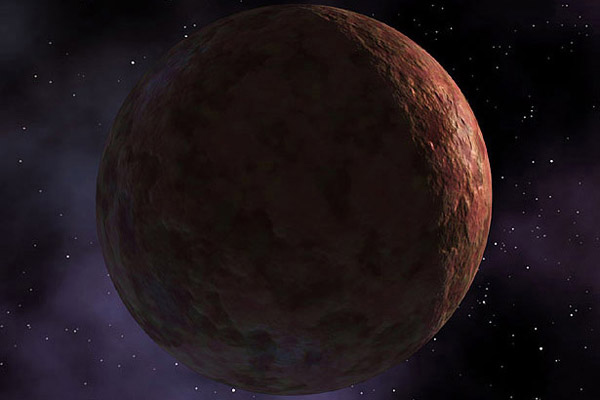 Artist's impression of the dwarf planet Makemake / nasa.gov
Artist's impression of the dwarf planet Makemake / nasa.govBeing the third brightest object in the scattered disc of the Kuiper belt did not help this planet from being discovered until 2005. It's high orbital plane did not help matters either as scientist were not looking up to find it. Because of its still recent discovery, there is very little information available on the planet. Most information is based on spectra images and theories at this current time. Perhaps during its aphelion (closest approach to the sun) we will gain a better understanding of the planet as we will be able to see it much more clearly then.
Discovery
When first discovered on March 31, 2005, by the Palomar Observatory team lead by Michael Brown, Makemake (pronounced Maki Maki) was nicknamed the "Easter Bunny". This was in reference to the fact that it was found so soon after Easter. Originally they were not going to announce their discovery, along with Eris, for some time but the controversy of who discovered Eris occurred and they announced their discoveries on July 29, 2005. It was missed for some time and other objects in the Kuiper Belt that was not as bright as Makemake were discovered first because of its high orbital plane.
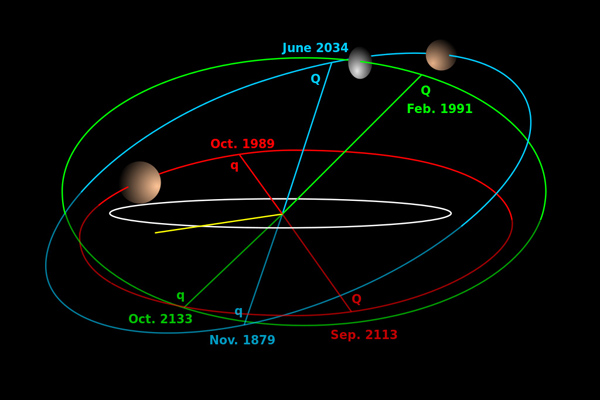 Orbits of Makemake (blue), Haumea (green), contrasted with the orbit of Pluto (red) / wikipedia.org
Orbits of Makemake (blue), Haumea (green), contrasted with the orbit of Pluto (red) / wikipedia.orgAstronomers tend to search for objects that circle the sun just as Earth does, but Makemake orbits the sun at a high eccentric orbit, similar to Eris. One year later, the International Astronomical Union (IAU) announced Makemake's classification as a dwarf planet plutoid and gave it a name. In keeping with the Easter idea, they named the planet after the Easter Islands Rapa Nui people's God of Fertility.
Position to the Sun
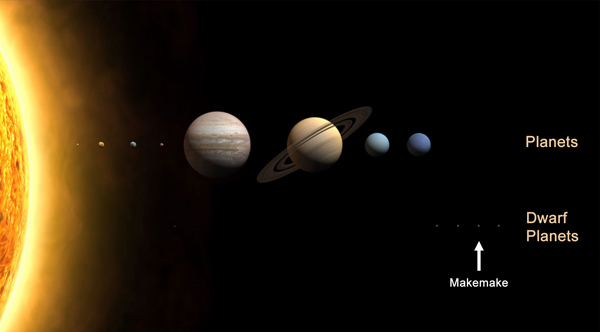 Position of Makemake in the Solar System / nasa.gov
Position of Makemake in the Solar System / nasa.govMakemake is approximately 6.85 billion km (4.26 billion miles) from the sun and it takes 310 years for it to complete its rotation at a 29° angle. This makes it a member of the "dynamically hot" class of classical KBOs as its angle of orbit to the sun is very high. Makemake is not due to come into its aphelion until sometime in 2033 which will bring it to its closest to the sun. We may be able to get a closer look at Makemake around that time. Makemake is the second brightest object in the Kuiper Belt capable of being seen through a high-end amateur telescope from Earth at an average albedo (light reflection) of 0.81.
Internal Structure
Currently, there is no information on the internal structure of Makemake. Being newly discovered and its extreme distance prevents any astronomers from getting a full analysis of the planet. Most of what is known is based on spectra images and speculation. Its mass is estimated at 0.00067 Earth mass which is only slightly different than Haumea's which is at 0.00070. This indicates that Makemake has a similar internal structure as Haumea in having a silicate rock interior with a thin mantle of methane ice.
Surface/Geography
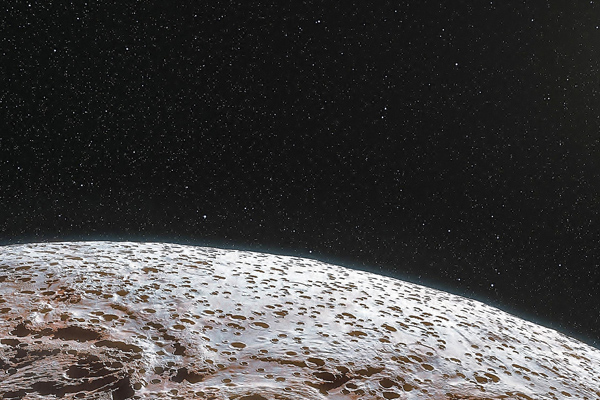 Artist's impression depicts Makemake's surface / nasa.gov
Artist's impression depicts Makemake's surface / nasa.govOne distinction about Makemake is that it has an almost perfect spherical body due to its fast rotation. It is estimated that the average diameter of the planet is approximately 1,300 to 1,900 km (808 to 1,181 miles) which make it smaller than Pluto and Haumea. This makes it the third largest of the dwarf planets. Analysis of the spectral images of the planet shows that large "grains" of methane may exist on the planet, possibly 1 cm in size.
Other elements that show on the images to exist on the planets surface are large amounts of ethane and tholins (this element exists when ultraviolet light interacts with ethane) and smaller measures of ethylene, acetylene, and high mass alkanes (which is similar to propane) caused by the ultraviolet rays from the sun interacting with the methane on the planet converting its molecules into the alkanes.
Atmosphere/Climate
At first, astronomers believed that Makemake had a similar atmosphere to Pluto's but with a lower pressure. However, recent studies during Makemake's pass over of a star showed that it does not, in fact, have an atmosphere that can be detected. Spectra images, however, show that the planet appears very red in color and indicates that there is methane on the planet. The average temperature is estimated to be -240°C (-406°F) which would keep all elements on the planet in a heavy frozen form.
Moons
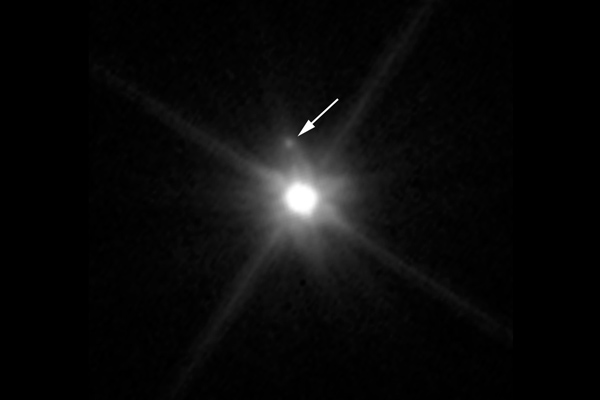 Makemake with its moon by Hubble Space Telescope / nasa.gov
Makemake with its moon by Hubble Space Telescope / nasa.govUntil April 2015, Makemake was thought to have no moons. Hubble Telescope captured images of the small dark moon and Marc Buie of South West Research Institute identified the small object orbiting Makemake. Designated MK2, it is a dark charcoal object, so dark it was unable to be seen except when it passed in front on Makemake during its rotation. Only approximately 160 km (100 miles) in diameter, it rotates at a distance of 20,900 km (13,000 miles) from Makemake and is 1300 times fainter than its parent planet. Though it had been spotted many times over the years since Makemake's discovery, it was mistaken for dark spots on the planet's surface until Buie recognized that it was the moon.
Exploration
There has yet to be any missions sent to Makemake and probes that have been in the "neighborhood" have not visited the planet as it was not on their predesignated path. Because of its extreme distance from Earth and high eccentric orbit, no future missions to observe this mysterious planet have yet to be made.
See also: All planets, Dwarf planets, Objects
Video Gallery

-
 Makemake and its moon facts
Makemake and its moon facts
-
 NASA's Hubble discovers moon orbiting Makemake
NASA's Hubble discovers moon orbiting Makemake
-
 Makemake: Song for kids
Makemake: Song for kids